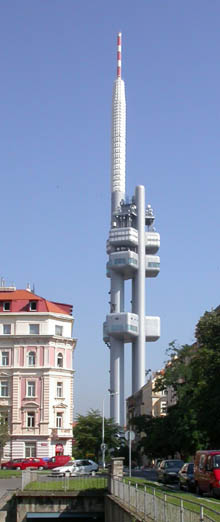
The Žižkov Tower is also an observation tower and a monument that inspires artists
 |
The transmitter, which was initially referred to as the Cosmic Rocket, Jakeš's Finger, or Biľak's Needle, serves, among other things, to broadcast television and radio signals and provides telecommunication connections for both fixed and mobile networks. It also functions as the main station for cable television distribution, for monitoring air quality, and as support for the radio stations of the emergency services and fire department. The first peering center (a wireless project aimed at connecting several internet providers into one entity) of the association NIX was also established here.
The decision to construct a new telecommunications center for Prague was made as early as 1978. The reason was the unsatisfactory technical condition of the television transmitter that had been operating at the Petřín lookout tower since 1953. An expert committee selected a location in Mahlerovy Sady at the boundary of Vinohrady and Žižkov from a list of ten sites. This site guaranteed the best coverage of the capital city with television signals and was also outside the flight path used by aircraft.
The tower's design was created under the leadership of architect Václav Aulický in 1984. Together with engineers Jiří Kozák and Alex Bém, Aulický designed a futuristic-looking structure that resembles a rocket ready for launch from a launch pad. Construction itself began in the autumn of 1985 and was completed with the ceremonial opening of the observation tower in February 1992. The total cost of construction at that time was around half a billion crowns.
The unusually designed tower has a triangular footprint, with steel columns with a circular cross-section rising from its vertices. Two of them extend 134 meters above the ground. At the same height, the third, wider tube transitions into a high antenna extension. The tip of the tower is situated 474 meters above sea level. The structure of the tubes consists of a double steel wall filled with concrete. At the time, it was a unique technology that its creators, along with the fiberglass cover of the antenna system, patented.
The foundation of the tower consists of a 15-meter deep, four-meter thick reinforced concrete slab with a diameter of 30 meters. The calculated deflection of the tower at the top can reach up to 120 centimeters. However, no oscillation is noticeable during normal operation because it is eliminated by a pendulum vibration damper.
The architects designed the tower not only as a purely technical structure but also as an observation tower. Therefore, at a height of 93 meters, there are three observation platforms from which visitors can observe not only Prague but also the surrounding landscape up to a distance of one hundred kilometers. Under ideal visibility conditions, it is possible to see as far as Hradec Králové, Ústí nad Labem, or Plzeň. Those who can forgo about 30 height meters can enjoy the view from the restaurant windows. A pair of high-speed elevators transports visitors to both public-access floors at a speed of four meters per second. The cabins at the highest floor of the tower serve transmission devices and their operators.
However, not everyone is a fan of the transmitter. From the time construction began, the project evoked considerable negative reactions. In connection with the social changes of 1989, many called for the construction to be halted and even demolished. Especially residents in the immediate vicinity feared the negative effects of electromagnetic radiation. Others criticized the structure for disrupting the city panorama with its dimensions or for being built in a park area of the Jewish cemetery.
Over the years, however, Žižkov has become accustomed to its "dominant feature." This has also been assisted by some projects. In 2000, for example, laminated babies by sculptor David Černý were installed on the tower, and they have been "climbing" it ever since, with a small pause. In 2006, the transmitter received permanent colored lighting. Last year, according to CzechTourism, it was visited by 146,000 people, making it the second most visited technical monument in the Czech Republic.
The English translation is powered by AI tool. Switch to Czech to view the original text source.
0 comments
add comment







